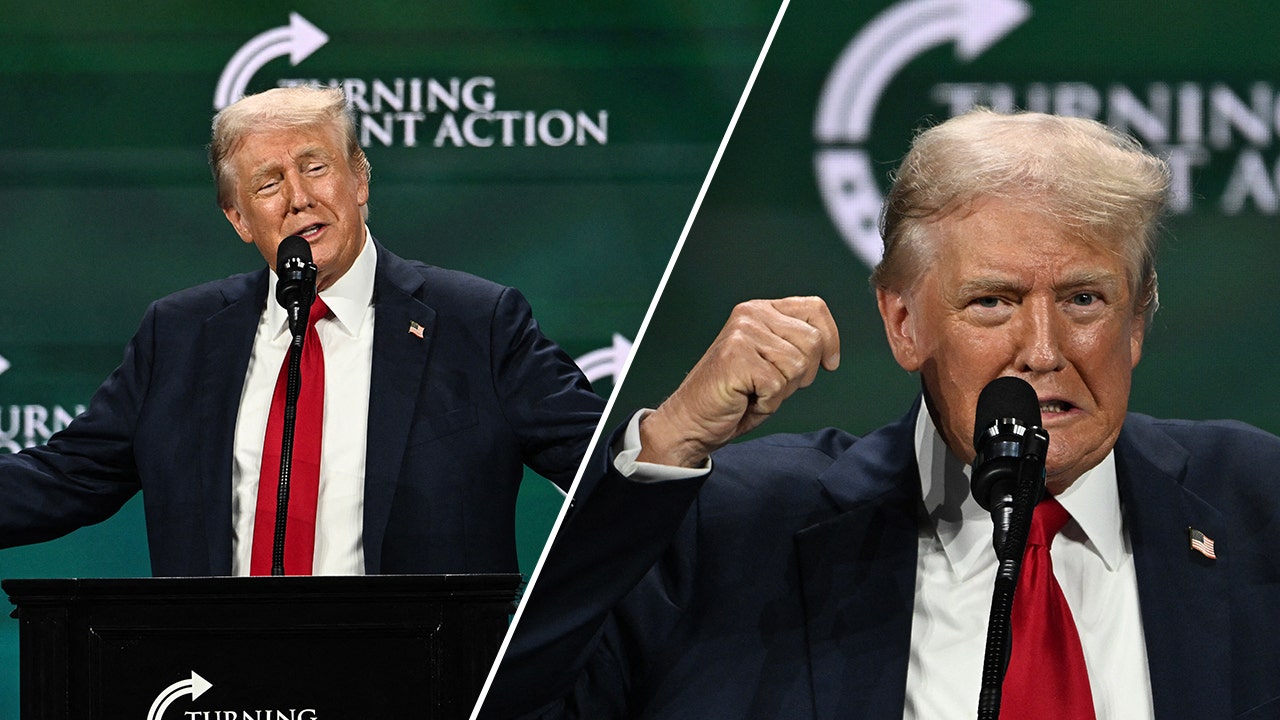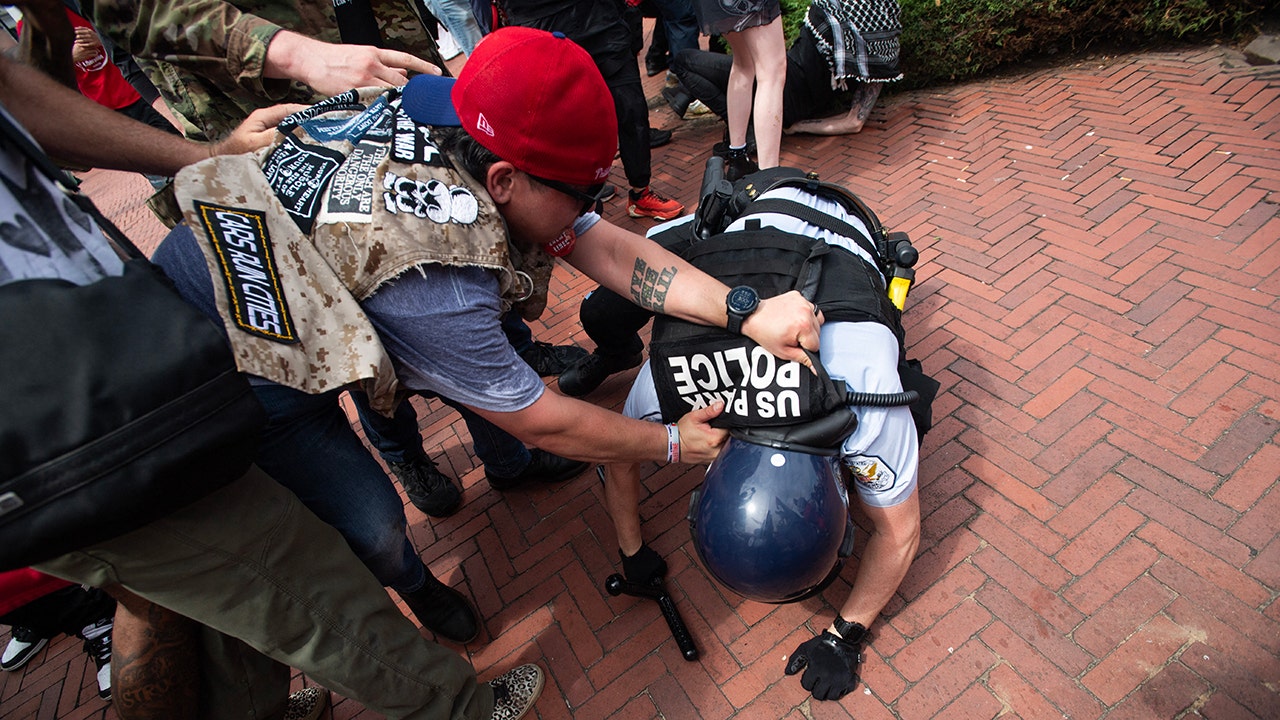Sports
Lessons from Jim Harbaugh's Chargers playing days: 'He's ready for the fight'

Ryan Leaf needed an ally.
The No. 2 pick in the 1998 NFL Draft was coming off a disastrous rookie season for the San Diego Chargers. Two touchdowns to 15 interceptions in 10 games. Eight fumbles and 22 sacks.
The young quarterback completed 45.3 percent of his passes and was benched multiple times. He alienated teammates and verbally accosted a reporter in the locker room. He recently described himself as acting “poorly … as a professional.”
The Chargers fired head coach Kevin Gilbride in October and finished the season 5-11. Leaf characterized the “mentality” of most in the organization at that time as, “If (Leaf) gets hit by a car on the way to work today, we’d be OK.”
That offseason, he was desperate for someone who viewed him differently, who focused on his potential and not his transgressions.
That someone became Jim Harbaugh.
“Everybody else was just like, ‘Screw this kid. I don’t want anything to do with him,’” Leaf recently told The Athletic. “(Harbaugh) wasn’t that guy, ever. He was always there to try to help.”
In two seasons playing quarterback for the Chargers, Harbaugh went 6-11 as a starter, throwing more interceptions than touchdowns. San Diego went 1-15 in 2000. Harbaugh’s final NFL pass attempt came in a Week 11 loss to the Miami Dolphins at Qualcomm Stadium.
Up until three weeks ago, this two-year stretch of Harbaugh’s legendary football life was a relative afterthought. But after Harbaugh was introduced as Los Angeles Chargers head coach on Feb. 1 at SoFi Stadium, this unceremonious end to a 14-year playing career now has revitalized meaning.
GO DEEPER
Home Depot, ‘Ted Lasso’ and an RV: What we learned at Jim Harbaugh’s Chargers introduction
To start the news conference, the Chargers played a hype video on two screens sandwiching each side of the podium. Included were several highlights of Harbaugh in a Chargers uniform. He sat in the front row, the giddy emotion evident on his face, smiling from ear to ear as reflections of the highlights danced on his glasses.
“All of these old memories are flooding back,” Harbaugh said after taking the stage moments later.
His connection to the team, the lighting bolt logo, Southern California, the Spanos family — it all stemmed from these two seasons. In the record books, the stint exists as a 9-24 record. But in the stories from the people who lived it, those two years were so much more — the burgeoning saplings of Harbaugh’s coaching style, raucous golf cart races at training camp, passion-fueled fights with teammates and an unwavering authenticity that resonates with teammates and coaches to this day.
“He beats to his own drum,” said former Chargers running back Terrell Fletcher, “and he likes the music he plays.”

Jim Harbaugh’s two seasons with the Chargers were a relative footnote to a solid NFL playing career until he was hired as their new head coach. (Keith Birmingham / MediaNews Group / Pasadena Star-News via Getty Images)
The Chargers hired Mike Riley as their new head coach after the 1998 season. Riley knew he needed a veteran presence in the quarterbacks room both as an aid and a contingency plan for Leaf. So on March 22, 1999, the Chargers traded a fifth-round pick to the Baltimore Ravens for Harbaugh, then 35 years old.
“What a great choice that was,” Riley said.
Harbaugh was a first-round pick of the Chicago Bears in 1987. In 1995, “Captain Comeback” led the Indianapolis Colts to the AFC Championship Game, beating the Chargers on his way there and making the Pro Bowl after the season. He had thrown for more than 22,000 yards by the time he joined San Diego
Riley was sitting in his office at the Chargers facility one offseason day when he glanced out the window to see rookies on the field going through a workout with the strength and conditioning staff, including lifting and carrying logs.
“You know how the weight coaches are,” Riley said with a chuckle.
As Riley looked onto the field, one player caught his eye, a lone veteran in the group of newbies.
“That’s just Jim,” Riley said. “Jim wasn’t normal.”
This is what Harbaugh brought to the Chargers when he arrived in San Diego in the spring of 1999: “He had an awareness of who he was on a team and what that would mean to the others,” Riley said.
The plan was for Harbaugh to back up Leaf. The previous year, the only other quarterback on the roster had been Craig Whelihan, a 27-year-old who was a sixth-round pick in 1995 and had seven career starts — all losses — to his name.
“We wanted to get a guy that would be not only a mentor type but would be a viable guy if something happened,” Riley said.
Minutes into the opening practice of training camp, Leaf tore the labrum in his throwing shoulder. The contingency became reality. Harbaugh was the Chargers’ starting quarterback.
He debuted for the Chargers on Sept. 19, 1999 — in Week 2, the team had a bye on opening weekend — throwing for 159 yards and two touchdowns in a 34-7 win over the Cincinnati Bengals. He suffered an elbow injury in the first quarter of the third game of the season against the Kansas City Chiefs. Veteran Erik Kramer, signed on the eve of training camp after being cut by the Bears, replaced Harbaugh and helped the Chargers overcome a 14-point deficit to win 21-14.
Kramer started the next two games, wins over the Detroit Lions and Seattle Seahawks (despite four interceptions from Kramer), while Harbaugh nursed the elbow and two cracked ribs. The Chargers were 4-1, with a defense led by linebacker Junior Seau and safety Rodney Harrison emerging as one of the better units in the league.
“We didn’t have a good defense,” said Fletcher. “We had a great defense.”
Harbaugh suited up against the Green Bay Packers in Week 7, but Kramer got a third consecutive start. He threw three interceptions in three quarters and was benched in favor of Harbaugh, who threw three picks of his own in the fourth. The Chargers lost, 31-3.
On the fourth play of a 34-0 loss to the Chiefs the following week, Kramer threw his 10th interception of the season. He fumbled on the next offensive series, the final snap of his NFL career. Harbaugh entered and went on to start the last nine games of the season. Kramer was forced to medically retire midseason because of a neck injury. He recalled waking up in the middle of the night unable to move in the days after the Kansas City game.

After replacing an injured Erik Kramer during a 34-0 loss to the Chiefs, Jim Harbaugh started the final nine games of the 1999 season. (Dave Kaup / AFP via Getty Images)
The Chargers lost six straight games to fall to 4-7. After Week 2, San Diego failed to score more than 21 points in nine straight games. Frustrations mounted among members of a defense that would finish the 1999 season allowing the fewest yards per play in the league.
“We were a little overmatched offensively,” Kramer said. “We didn’t have quite the talent.”
Tensions boiled over in Week 10 during a 28-9 loss at the Oakland Raiders, the fifth of six consecutive defeats. And Harbaugh was at the center of the flare-up.
The Chargers punted on all five of their first-half possessions to open the game, and safety Mike Dumas was waiting on the sideline to greet the offense after each failed drive.
“At first it was kind of encouraging. ‘Come on, offense. Let’s get it going,’” offensive tackle Vaughn Parker said. “But at a certain point in time, you’ve heard it, and it’s like, ‘We get it. We know we’re struggling. Give us a break.’”
The Chargers trailed 21-3 in the fourth quarter when Harbaugh threw an incompletion on a fourth-and-10.
“Mike said something,” Riley recalled. “Jim took offense to it.”
Dumas and Harbaugh got into a jawing match on the sideline. Television cameras picked up the spat.
“It’s really embarrassing us as a team,” Seau said at the time. “We don’t like to see any of our players and family members having a conversation like that in front of millions of people. It doesn’t need to be like that. We don’t need to expose our dirty laundry out there on the street.”
Offensive players, though, saw Harbaugh going to bat for them.
“You appreciate that, especially as an offensive line,” Parker said. “You still wanted to give a great effort for someone who was in it like you were.”
The Chargers lost, 28-9. Riley said he was jogging 20 yards behind Harbaugh and Dumas, who were continuing to yell at each other as they made their way across the field from the visitor’s bench to the Oakland Coliseum locker rooms after the game.
“They held themselves off until they got underneath the stadium and the seats before they actually went at it,” Riley said.
Fletcher pointed out that the fracas was a “football fight, not a real right.” But, he concedes, it is not often the starting quarterback is grabbing facemasks or throwing uppercuts. “That’s one thing that makes it unique,” Fletcher said, “he stuck up for himself.”
“Jim was not going to back down to anything,” Riley said. “That’s kind of his M.O. He’s ready for the fight, whatever it is.”
Harbaugh threw for 677 yards over the next two games. Three weeks after the Oakland loss, the Chargers ended their skid with a 23-10 win over the Cleveland Browns, with Harbaugh completing a season-high 69.6 percent of his passes.
“He is a mad-man competitor,” Parker said.
The Chargers won four of their final five games. The only loss came in Week 15 to the Dolphins. On the final drive, Harbaugh completed six passes to move the offense into field goal range. Kicker John Carney missed from 36 yards. San Diego lost 12-9, finishing one game back of Miami for the final wild-card spot.
The Chargers held training camp at UC San Diego during the years Harbaugh played for the team, complete with players sleeping in dorms and two-a-day practices. “Pads both times,” Fletcher said.
The field was far enough away from the dorms that the team gave players golf carts to shuttle there and back. “They were gas carts,” Parker said. “You could pop the regulator (off) and just make it so much more fast than they anticipated.” Parker remembers a “huge straightaway” on the drive from the dorms to the field.
Compulsively competitive people? Uncapped golf carts? Huge straightaway? Exhausted players craving a reprieve from the dog days of camp?
“We raced the golf carts,” Fletcher confirmed. And who was the ringleader? Fletcher pauses for a second when asked. “It might have been Jim,” he says with a laugh.
Harbaugh, months away from his 37th birthday, was pushing the carts to the limit.
“We had all kinds of things — wrecks and guys falling off,” Fletcher said. “You’d have four people in the cart, two people on the back, the cart’s scratching the ground almost because it’s almost a ton of weight on the carts.”
“Everyone was just ripping,” Parker said.
When teammates think back to 2000, these are the front-of-mind moments. Harbaugh’s levity was among the few positives in a horrific season when the Chargers did not win a game until after Thanksgiving.
Leaf had rehabbed from shoulder surgery and entered training camp in a competition with Harbaugh for the starting job. He completed his first nine pass attempts in a preseason win over the Atlanta Falcons on Aug. 18, finishing the first half with 167 yards and a touchdown.
Not long after, he claimed the starting job. And after the decision was made, Leaf said, Harbaugh was “accepting” and “just nurturing.”
“He all of a sudden became the mentor,” Leaf said. “He became the coach in that quarterback room.”
The Chargers lost the first two games of the season by four combined points, but Leaf threw five picks and lost a fumble and was benched for a Week 3 game against the Chiefs in favor of Moses Moreno. Moreno suffered a throwing-shoulder injury in the third quarter of an eventual 42-10 loss to the Chiefs.
Harbaugh saw his first action of the season the next game against Seattle after Leaf fumbled and threw an interception in the first half. Harbaugh started the next five games, but Leaf got the nod for the final six, including a Week 13 win over the Chiefs, the Chargers’ lone victory of the season.
“It challenged everything (Harbaugh) believes in,” then-quarterbacks coach Mike Johnson said of the 2000 season. “It challenged the way he believes in how you should handle coaches, how you should handle players, everything. Jim Harbaugh has probably never gone 1-15 in anything.”
“A year that’s etched in my memory,” Parker said.
Amid the losing, though, Harbaugh was still making the type of connections that would come to define him as a coach.

Despite the on-field struggles, Jim Harbaugh was planting the seeds of what would make him a successful NFL and college head coach. (Stephen Dunn / Getty Images)
Leaf looked forward to Tuesdays. On the players’ off day, Leaf, Harbaugh and Moreno would play a round of golf. Each week, one quarterback rotated picking the course. Part of the selection process was identifying a course that fit one’s golf game. But Harbaugh was working on a deeper level.
“He always found a really interesting way to corroborate the golf course with kind of a message,” Leaf said.
One Tuesday, Harbaugh picked the course at Coronado to build a theme around the military.
“Everything he did had a coach feeling to it,” Leaf said. “There was always a bigger message that was being sent in everything he did, from the clothes he’s wearing to the golf course he picked for us to play at so he could share stories along the way.”
Don’t be mistaken, though: Harbaugh was vicious during these rounds. Sure, he was coaching — on these days more about life than football. He was also competing.
“They were brutal,” Leaf said. “He suffered no fools, and there was no quarter given. If it was a two-footer to win the hole, he was making you putt it out.”
Still, Harbaugh, in his way, found a way to connect with a man who had lost his connection to virtually everything else in his football life. Leaf said he invited four members of the Chargers organization to his wedding. One was Harbaugh.
“Those two years … he ended up being my best friend,” Leaf said.
It was an unlikely pairing.
“Ryan Leaf and Jim Harbaugh were oil and water,” Johnson said. “Ryan was something that Jim couldn’t understand. ‘How can you be this talented and not be more like me?’”
Johnson remembers one time in the quarterbacks room in 2000, Harbaugh turned to Leaf and said, “Look, Ryan, you’re a poor excuse of a pro athlete. Do your job and make sure you take care of the things you need to take care of to make sure you’re a pro.”
“That’s who Jim was,” Johnson said. “He was not going to allow you to be anything less than what you were supposed to be.”
Harbaugh was supposed to coach. That much was obvious during his playing days. He sat on the sidelines with the Carolina Panthers in 2001 before retiring and setting out on his next career the following season as the Raiders’ quarterbacks coach.
He won a Pioneer Football League title at the University of San Diego in 2005. Five years later, he led Stanford to its first 11-win season in program history and an Orange Bowl title. He took the San Francisco 49ers to the Super Bowl after the 2012 season, and a nine-year run at the University of Michigan, his alma mater, culminated in a national championship in January.

GO DEEPER
Meek: Jim Harbaugh at Michigan could have ended badly. Instead, he delivered a parade.
“You want to be on Jim’s side,” Riley said. “There’s no doubt about it.”
Passionate, principled, driven and authentically himself — that is the legacy Harbaugh left as a Chargers player.
Now he builds a new one.
(Top illustration: Sean Reilly / The Athletic; photos: Brian Cleary and Tom Hauck / Getty Images)

Sports
Leny Yoro, from Paris boy to Man Utd: 'He had the same speed as Kylian Mbappe'

There are always Sliding Doors moments in a player’s career; points when a lifetime’s path takes a critical turn, based on what feels like a coin toss.
In Leny Yoro’s case, it happened in the form of a red card.
On October 20, 2021, Baptiste Rolland’s dismissal for Lille Under-19s against their Sevilla counterparts in the UEFA Youth League transformed Yoro’s trajectory. Centre-back Rolland was dismissed in the 79th minute for pulling the shirt of Diego Rodriguez. Yoro, just 15 years old and previously a striker and then midfielder, came on to play in defence for the final few minutes, his first appearance for the French club’s under-19s side. The sending-off and Rolland’s subsequent suspension meant Yoro would start the team’s next Youth League fixture, the return at home against Sevilla.
It was the last time Olivier Szkwarok, who was in charge of Lille Under-16s at the time, would coach him.
“When Leny was an under-16, I said to the under-19 coach that he needs to play in the under-19s, but he didn’t have a place for him,” Szkwarok, now working as a youth coach at Toulouse, another French club, tells The Athletic. “But the first time he (started for the under-19s), he never returned with me. He was the best on the pitch.
“On that day, Liverpool and Monaco saw a lot of potential in him. After that, he was with the under-23s, and it was easy for him. Lille needed him to sign a professional contract and they invited him into the first team. Jocelyn Gourvennec, the first-team coach, loved his potential and said he could train with professionals full-time.
“I was a little surprised, but not surprised. Leny is a competitor and a hard worker.”
Yoro had joined Lille in 2017 from local side Villeneuve-d’Ascq. He initially grew up in Saint-Maurice, a suburb of Paris, 137 miles (222km) to the south, where he played his football in a playground opposite his home. Then he played for Alfortville, in the south-east of the French capital. His three brothers — Esteban (14), Eden (12) and Romeo (10) — all play football too; his father, Alain Yoro, had been in Lille’s academy himself as a teenager.
When Yoro was young, his parents split up and his mother, Flore Baugnies, moved the family to Bormes-les-Mimosas on France’s south coast for six months, before then going to Lille, in the north of the country near the border with Belgium, to be closer to family. That was when Yoro joined Villeneuve d’Ascq, known locally as VAM.
United’s Yoro battles with Rangers’ John Souttar last week (Ian MacNicol/Getty Images)
“The club is located in a working-class neighbourhood,” recalls Aboubacar Sankhare, the former Lens, Toulouse and Dusseldorf defender. “At the time Leny was there, I was the club’s general manager. He stayed at the club with his brothers for two-and-a-half to three years.
“From a very young age, he had this ability to adapt quickly, and he had this maturity. He understood instructions very quickly. He already had intrinsic qualities of his own. He played with the team of his age and a higher category (age group). He had his siblings, and his mother came to see them every day at the stadium. It was a social club.”
VAM fell into financial difficulties and no longer exist. At the time, though, Sankhare was leading the club’s social and educational projects, in addition to training youth sides with a view to some of those kids reaching the first team. In addition to Yoro and his brothers, Sankhare’s sons, Yssouf and Zakary, also joined professional clubs after playing at VAM.
Yoro stood out. But not in the position you would expect.
“He was a striker with us, and could play in all positions because he could adapt extremely quickly,” recalls Sankhare. “The Lille scouts came several times and reported on him. At the time, there were the biggest clubs in the region — Lens, Lille, Valenciennes, Dunkirk, Boulogne — who came to scout. He became a defender at Lille.”
When he went to Lille for a trial, Yoro impressed immediately. That was when Szkwarok, who coached the under-13s and then the under-16s at the club, first saw him play. “I loved him from the trial,” he recalls. “He was a different player. When he was 12, he was the same as now. For a tall player, he had good technique. But he was missing the speed. He had a good personality. Like today, he was a leader who always encouraged his team-mates.”
The years Szkwarok worked with Yoro bookmarked a critical period in his development. Yoro initially played in midfield, before switching positions. “He was a defender full-time from under-15,” says Szkwarok. “He had a very good technical level and a very good in-game intelligence. He can see and play quickly, with his left or right foot, and I think, at professional level, he can play in midfield if a coach needed him to. A little bit like John Stones at Manchester City. In my opinion, Leny has a better potential than John Stones.”
But not everything was straightforward.
“All of the coaches loved him for his personality but not all of them believed in him,” says Szkwarok. “In the under-14s, it was a little bit complicated. A coach said in a meeting that Leny does not have the potential to play at the highest level. For me, it was a big error to say that about Leny. Because he was a tall player, and we needed to give him a little bit of time to grow up, and after he can show his potential.”
Yoro had a growth spurt before the age of 16. Speaking to French newspaper La Voix du Nord, mum Flore recalled how “he gained 10 centimetres (almost four inches)” during his under-16 year but “all year long, he was injured”. “He injured himself, without taking any hits during matches,” she said. Yoro had to adapt to his changing body and Lille tailored their coaching to deal with his small, repetitive muscular issues.

Yoro going up against Kylian Mbappe in Ligue 1 last year (Franck Fife/AFP/Getty Images)
“Leny was always the tallest but he grew and it (led to) small injuries,” says Szkwarok. “He had them often. Two days (out of action), three days, four days. We found a solution and after we changed our method of training with him, he could train all day and played all the games.
“When he was an under-16, at the beginning of the season, we went to a small tournament. He hadn’t played during the season so in his first game, to protect him, I put Leny in midfield. Against (Belgium’s Club) Bruges and PSV (Eindhoven, from the Netherlands), he played very well. In defence you have to make more runs in behind, longer runs, and in midfield they are shorter.
“In order to adapt to his new body, he worked a lot. That’s why he’s always a good player technically and this part of his character is a very good example for his career in football.”
Yoro became one of the quickest and strongest in the group. But those years without exceptional pace had honed his ability to read the game too. It is a key trait, normally confined to experienced players, and it is something scouts picked up on when assessing him.

GO DEEPER
Leny Yoro to Manchester United: The Athletic 500 transfer ratings
“When he played against (France captain and now Real Madrid forward) Kylian Mbappe, he had the same speed as him,” says Szkwarok. “But when he was younger, Leny did not have a lot of speed and he developed the ability to read the game, both defensively and offensively. It is his best quality. A very intelligent player.
“He had the mentality of a defender. He loved defending, he loved intercepting the ball, winning the ball with his head. It is a little bit rare to have both qualities, to have technique and the mentality of a defender.”
Then came those under-19s matches against Sevilla in late 2021, under coach Stephane Pichot, and Yoro’s progress went up several gears. “It all started from there, because he played two more Youth League matches afterwards,” his mother said. “That’s where his No 15 comes from (which Yoro will now also wear at Manchester United). Because it all started when he was 15 years old.”
In October 2021, Yoro played with Lille Under-19s for the first time. By the following May, then aged 16, he had made his debut for their first team — coming off the bench away at Nice. In the process, he became the club’s youngest player since Joel Henry in 1978, surpassing Eden Hazard. He was invited to stay with the first team under new manager Paulo Fonseca in summer 2022 and, after just two days of pre-season training, the Portuguese coach had made up his mind.

Yoro holding back Aston Villa’s Ollie Watkins in the Europa Conference League last season (Justin Tallis/AFP/Getty Images)
“In all my years as a coach, I’ve never seen such a young player with so much maturity,” Fonseca told The Athletic last year. “He has so much class. So much elegance. He’s a beautiful player.” In the September, he became Lille’s youngest starter since Oumar Dieng in 1989.
“When we started to work with Leny, we saw a lot of potential,” Tiago Leal, Fonseca’s assistant, tells The Athletic. “We didn’t care about his age. We care about his skills. Technically, tactically, mentally, personality, character… he had many things that for his age were not normal.”
Taking the step into the professional game is never plain sailing, though. His full debut against Toulouse, a 2-1 Lille win, was a case in point. He won four of five aerial duels but also made an error that led to the Toulouse goal — a loose pass. He needed time, and the right environment, to adjust.
Under Fonseca, he would get that. Now in charge at AC Milan, Fonseca is no stranger to bringing through young talent, doing so with Diogo Jota (now of Liverpool and Portugal) at Pacos de Ferreira and then Mykhailo Mudryk (Chelsea and Ukraine) at Shakhtar Donetsk.
“In the first season, he made many mistakes that cost us many games, but for us, it was not a problem at all,” says Leal. “We knew it was part of the process with younger players. He was brave, because he never stopped trying to do what we demanded of him. We made a bet on him and as a team we were ready to pay the costs of this bet.”
Yoro’s first season of senior football was a learning curve. He made eight league starts and 15 appearances for Lille’s first team. How he responded to those inevitable rookie errors set him apart. “He’s really mature, his composure is not normal at his age,” says Leal. “That’s what impressed us. It wasn’t just because of his physical or technical qualities. It was the package. He was different from most of the others at his age.
“When he made mistakes, what I felt is that he was always stable, and that says a lot about his personality. He was always focused on his work, always trying to improve every day, not dependent on winning, losing, making a goal or not. He was always stable. That’s why he has this level of attention with Real Madrid, Paris Saint-Germain, clubs like that spotting him. Because it is special at his age.”
𝑻𝒉𝒆𝒏 & 𝒏𝒐𝒘 😍
Leny Yoro et nos diplômés 2023 ont reçu leur BAC lundi au Domaine de Luchin 🎓@leny_yoro ❤️ pic.twitter.com/ZjaMixgnX4
— LOSC (@losclive) April 24, 2024
Under Fonseca, Lille played an expansive brand of football, the coach demanding that his team press high up the field, take risks in possession and sometimes leave their defenders exposed with half a pitch of space in-behind. “Leny showed from the very beginning that he wanted to learn, to improve, and this is an important aspect of his character,” says Leal. “He is humble. When you have the skills technically, and when you are physically blessed — he’s really tall, fast, explosive — you need the desire to be better and courage to play the game we demand. He showed that from the beginning.”
His second season, 2023-24, bore fruit. Yoro started 30 league matches and featured in 44 games in all competitions. He succeeded the experienced Jose Fonte in Lille’s starting lineup, who had been a “role model” for him within the group according to Leal, along with the new captain Benjamin Andre. “He needed the mix of many things to help the flower grow,” says Leal. “We didn’t create the flower, we just gave it water, nutrients — the others and us are the gardeners.
“In the second season, he became the player we expected. He became more confident in himself, started to build this ego that you need, because he was ready to take his place in the team. He became almost complete. And we are speaking about a kid. I don’t have any doubts, about Leny. He’s getting what he deserves.”
His form earned him a place in the Ligue 1 team of the season, and elevated his status to one of the most exciting centre-backs in Europe. It was enough to persuade Manchester United to spend £52million ($65m; €62m), potentially rising to £59m, and fight off serious competition, making Yoro the most expensive player ever aged 18 or younger. (Mbappe was signed initially on a season’s loan by PSG before his €180m transfer from Monaco at age 19.)
Throughout his career, Yoro has quickly adapted to every challenge. United, English football and the Premier League will be a different order of magnitude but Leal feels he can thrive again.
“We cannot forget he is a young kid,” he says. “He is not going to solve every problem at Manchester United. Not alone. But if he gets a proper environment around him and the space and confidence to participate, I’m pretty sure he is going to be a main player for them.”

GO DEEPER
How Manchester United beat Real Madrid to the signing of Leny Yoro
(Top photos: Getty Images; design: Eamonn Dalton)
Sports
Charles Barkley says he has 'spoken to all 3 networks' during TNT's dispute with NBA over media rights bid
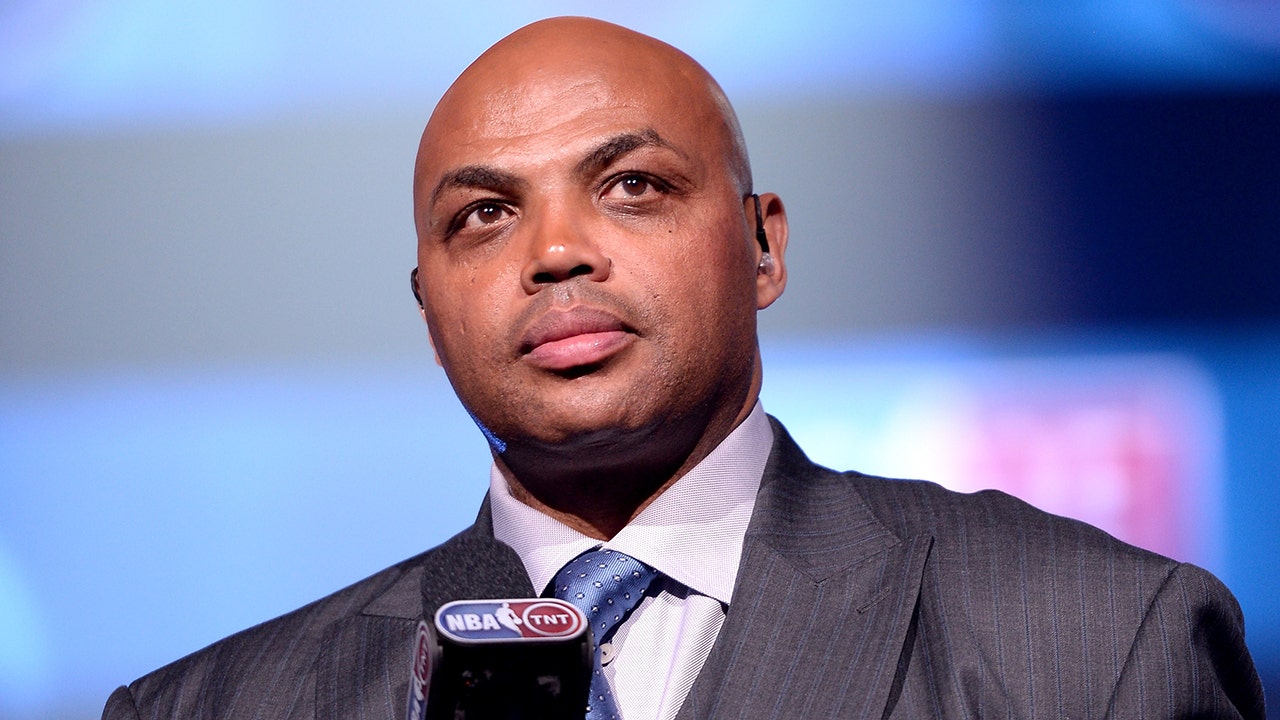
The NBA rejected a bid from Warner Bros. Discovery (WBD) to exercise its right to match an offer from Amazon for a part of the league’s 11-year, $76 billion media rights deal Wednesday.
Less than 48 hours after the announcement, WBD, TNT’s parent company, filed a lawsuit under seal in New York County Supreme Court.
Charles Barkley, the Hall of Famer and longtime co-host of TNT’s popular “Inside the NBA,” reacted to the company’s failed attempt to renew media rights.
“Clearly the NBA has wanted to break up with us from the beginning. I’m not sure TNT ever had a chance,” he wrote in a statement. In June, Barkley revealed his intention to retire at the conclusion of the 2024-25 NBA season. On Friday, he hinted he was open to other opportunities.
Charles Barkley speaks onstage Feb. 12, 2015, in New York City. (Stephen Lovekin/Getty Images for American Express)
“I have spoken to all three networks. … I have spoke to three networks,” Barkley said Friday during an appearance on the “Dan Patrick Show.”
When Patrick asked whether Barkley would follow through with his retirement plans since he was fielding calls from other media companies, the NBA legend said he was “going to listen” to what the networks had to say.
‘INSIDE THE NBA’ HOST CHARLES BARKLEY HINTS SPLIT WITH LEAGUE WAS INEVITABLE: ‘NOT SURE TNT EVER HAD A CHANCE’
“First of all, I’d be stupid not to take their call, but the beauty of this situation … I don’t have to make any decision for a year, Dan,” Barkley said. “But I told all three networks, ‘Hey I’m honored. I’m flattered that ya’ll want to talk to me, but let’s see what happens in a year.”
In May, the Sports Business Journal reported that Barkley has a clause in his contract that allows him to go elsewhere once the network’s NBA deal runs out.
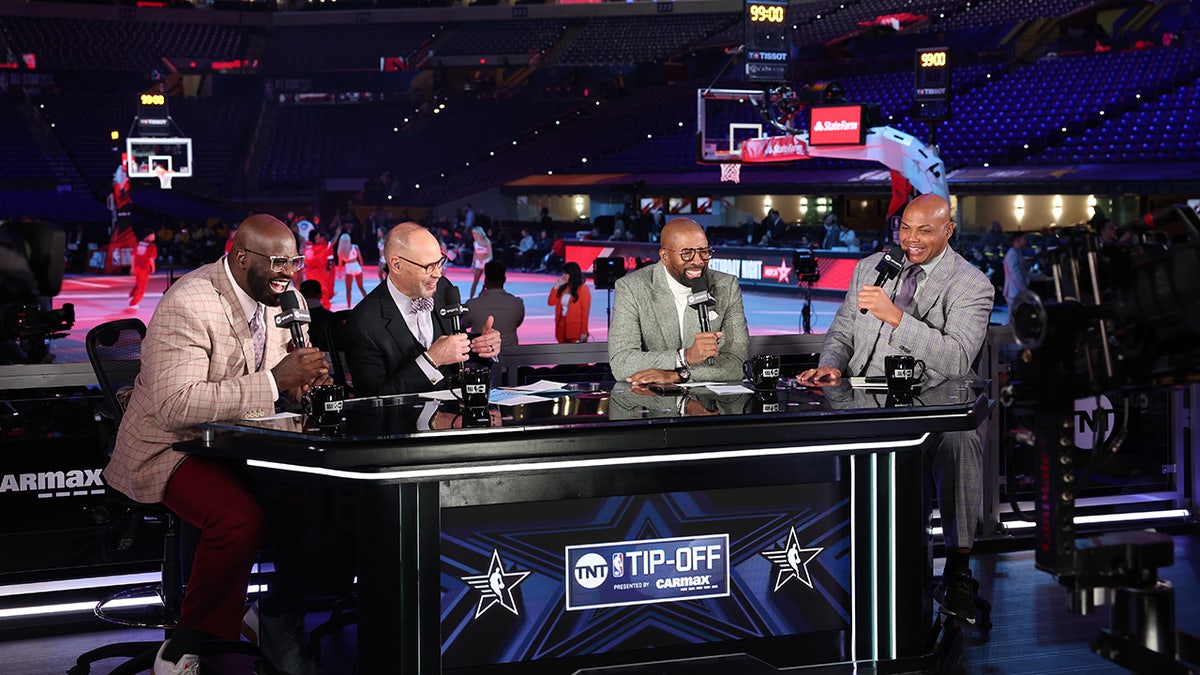
Shaquille O’Neal, Ernie Johnson, Kenny Smith and Charles Barkley from TNT talk Feb. 17, 2024, at Lucas Oil Stadium in Indianapolis. (Brandon Todd/NBAE via Getty Images)
Barkley confirmed the terms of his lucrative contract with TNT and revealed the deal is structured in a way that allows him to become a free agent once the 2024-25 NBA season ends.
“My deal is ten years, $210 million. Next year will be year three,” Barkley told Patrick. “Turner has to come to me today or next week and say, ‘Hey, we screwed up. Will you take a payout?’ So, they are going to have to guarantee the whole ten years, $210 (million), or they are going to have to ask me to take a pay cut, which, under no circumstances am I taking a pay cut. Zero chances of me taking a pay cut.”
He added that while he anticipates being a highly sought media personality next year, he also reaffirmed his intention to bring his broadcasting career to a close.
“But I don’t see them (TNT) guaranteeing it to be honest because they don’t really have anything. So, I think I’m going to be a free agent next summer. Right now, my intention is to retire.”
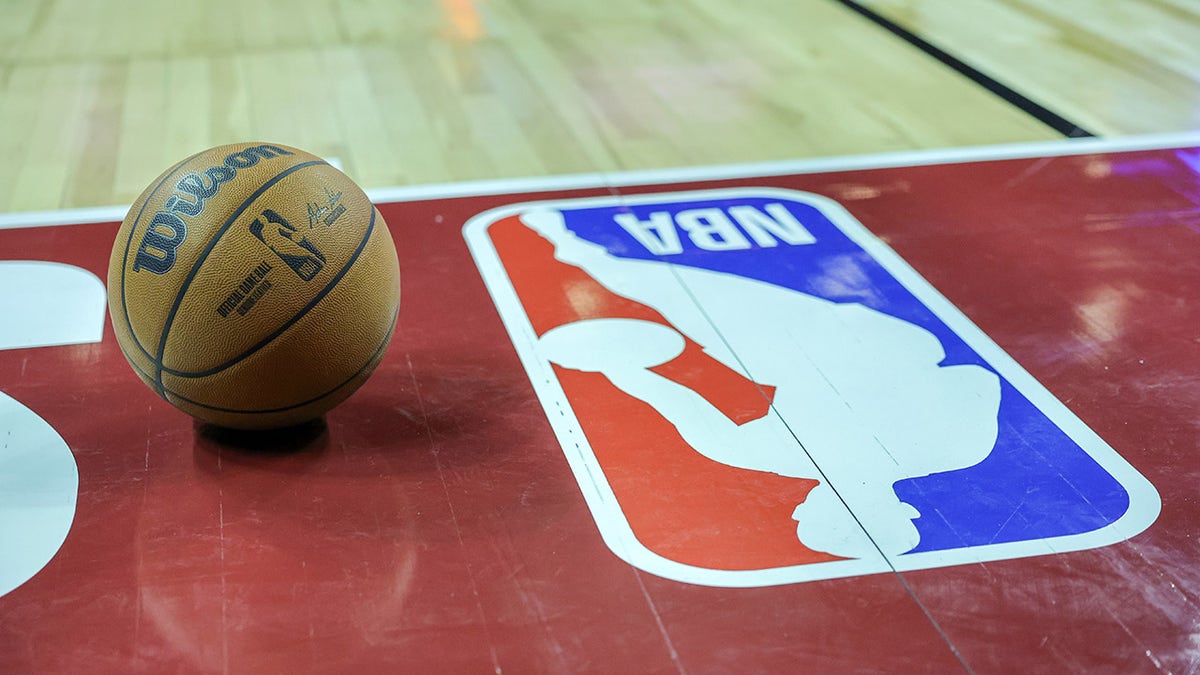
A basketball on the court next to an NBA logo during a break in the first half of a game in Las Vegas. (Ethan Miller/Getty Images)
The terms of the new media rights agreements maintain broadcasting rights for Disney’s ABC and ESPN platforms, while also marking the return of NBA games to NBC and the introduction of games to the company’s Peacock streaming service. Amazon Prime Video also picks up a package of games slated to begin after the 2024-25 season.
However, the lawsuit from WBD signals that the battle for the NBA’s broadcasting rights could ultimately play out in a courtroom. WBD released a statement explaining its decision to file the suit.
“Given the NBA’s unjustified rejection of our matching of a third-party offer, we have taken legal action to enforce our rights,” WBD said in a statement. “We strongly believe this is not just our contractual right, but also in the best interest of fans who want to keep watching our industry-leading NBA content with the choice and flexibility we offer them through our widely distributed WBD video-first distribution platforms – including TNT and Max.”
Follow Fox News Digital’s sports coverage on X, and subscribe to the Fox News Sports Huddle newsletter.
Sports
Angel City scores road win over Bay City in Summer Cup
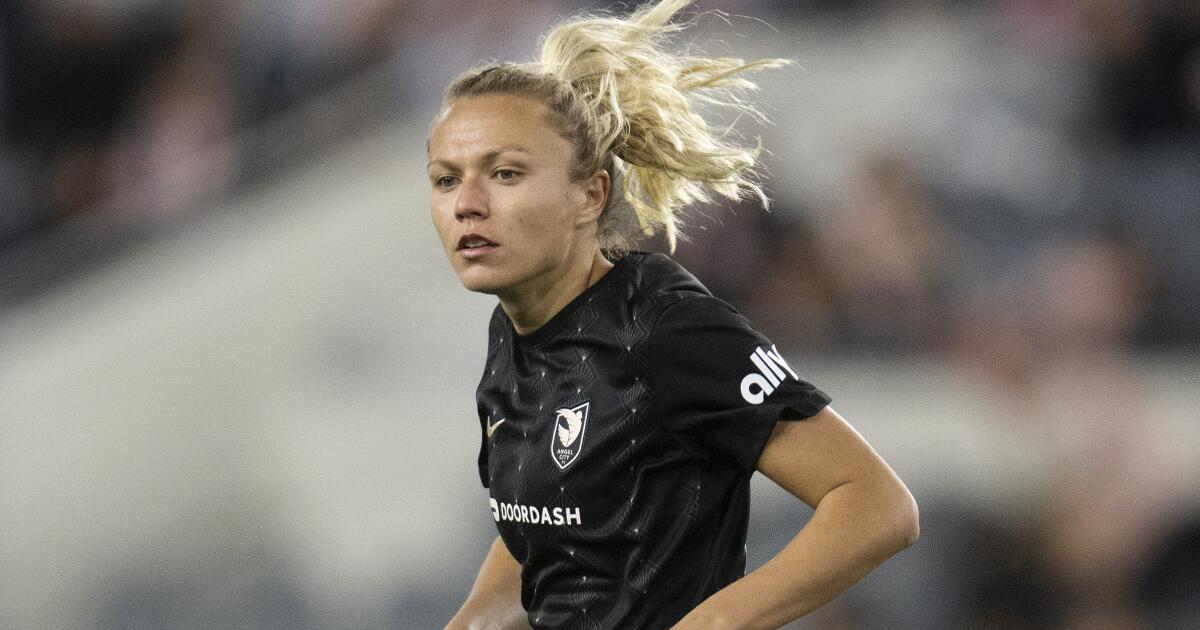
Claire Emslie scored in the 54th minute to add to Angel City’s lead, and the defense held firm in a 2-0 road win over Bay FC in a group game of the NWSL x Liga MXF Summer Cup.
Angel City’s first goal came in the 18th minute when Dorian Bailey of Bay FC accidentally knocked the ball into her own net.
Angel City next faces San Diego Wave Thursday.
-

 World1 week ago
World1 week agoOne dead after car crashes into restaurant in Paris
-

 Midwest1 week ago
Midwest1 week agoMichigan rep posts video response to Stephen Colbert's joke about his RNC speech: 'Touché'
-

 News1 week ago
News1 week agoVideo: Young Republicans on Why Their Party Isn’t Reaching Gen Z (And What They Can Do About It)
-

 Movie Reviews1 week ago
Movie Reviews1 week agoMovie Review: A new generation drives into the storm in rousing ‘Twisters’
-

 News1 week ago
News1 week agoIn Milwaukee, Black Voters Struggle to Find a Home With Either Party
-

 Politics1 week ago
Politics1 week agoFox News Politics: The Call is Coming from Inside the House
-

 News1 week ago
News1 week agoVideo: J.D. Vance Accepts Vice-Presidential Nomination
-

 World1 week ago
World1 week agoTrump to take RNC stage for first speech since assassination attempt








/cdn.vox-cdn.com/uploads/chorus_asset/file/25547597/Screen_Shot_2024_07_26_at_3.55.30_PM.png)





